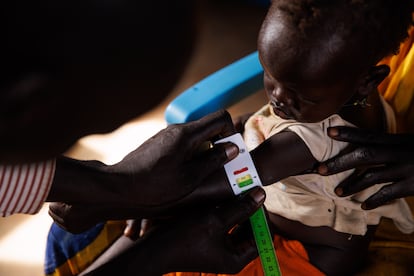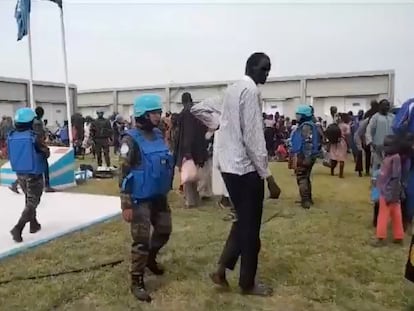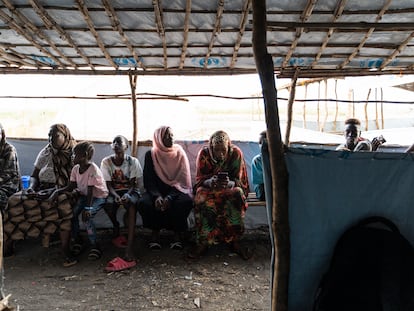War pushes Sudan toward famine
About 40% of the country is experiencing severe hunger, with seven million people at risk of starvation

Eleven months after a civil war erupted in Sudan between the regular army and a powerful paramilitary group, over 95% of Sudanese struggle to afford a full meal daily. Communal kitchens set up to help are facing repression and resource shortages. Tragic stories of severe hunger and death, especially among children, in the hardest-hit areas are a daily reality. Cindy McCain, the World Food Program’s (WFP) executive director, warned that the conflict in Sudan could lead to the world’s worst hunger crisis. The United Nations Office for the Coordination of Humanitarian Affairs (OCHA) estimates that around 18 million people — 40% of the population — are facing acute levels of hunger.
More than 95% of Sudanese cannot afford a full daily meal
“The war that started in April 2023 has led to the world’s biggest humanitarian disaster, triggering a famine like we haven’t seen in 30 years. And still, people have decided to turn a blind eye,” said Anette Hoffmann, a researcher at the Clingendael Institute in the Netherlands who studies hunger in Sudan.
The country’s current hunger crisis is particularly concerning as it unfolds towards the end of the harvest season (October to February), a time when food availability is typically higher. This signals a grave situation ahead, with projections suggesting that around seven million people could experience severe hunger by mid-year. Factors contributing to the food crisis are the war, security issues, lower agricultural output, rising inter-community violence, inflation and limited humanitarian aid.
Some war-affected regions like Darfur, Kordofan and Gezira, known for their agricultural productivity, face challenges in sustaining rural activities. Mass population displacement and military conscription drives have significantly limited the available workforce. The capital’s devastation has disrupted the financial sector, leaving farmers without credit for essentials like machinery, seeds and fertilizer.
The current hunger crisis is particularly concerning as it unfolds towards the end of the harvest season when food availability is typically higher
Fighting and looting in Khartoum have crippled the agri-food industry centered in the capital, leading to skyrocketing food prices. The official inflation rate hasn’t been revised since February 2023, but the WFP estimates it to be over 300%.
The nearing famine
Starting in June, the country is projected to face severe hunger levels, as per Hoffmann’s recent study. Nearly 40% of the population (18 million people) will have access to less than half of their daily energy requirements, and around 15% (seven million people) will have less than one-third of their daily energy requirements.
The World Health Organization (WHO) stresses that malnutrition weakens the immune system, leading to higher illness and death rates and making it easier to catch diseases, particularly among pregnant women and children. From May to September last year, over 1,200 children under five died in refugee camps in White Nile State in southern Sudan, due to a what the UNHCR called the deadly combination of malnutrition and a measles outbreak.
The official inflation rate hasn’t been revised since February 2023, but the WFP estimates it to be over 300%
Hunger in Sudan is escalating swiftly, and has been flagged as a major humanitarian crisis by several U.N. agencies. Currently, 25 million people, over 14 million of whom are children, require aid. More than six million have been displaced since the war began, marking it as the largest such crisis globally.
In the conflict-affected areas, 70-80% of the hospitals are closed, leaving 65% of the population without healthcare. Additionally, 19 million school-age children are unable to continue their education. The World Bank estimates that the Sudanese economy contracted by 12% last year, and the International Monetary Fund (IMF) anticipates that it could contract by 18% in 2024, a huge collapse considering that the economies of Yemen and Syria have contracted by an average of 5% annually over the past decade.
To date, large humanitarian agencies have distributed food to approximately six million people, as per data from OCHA’s Food Security and Livelihoods Fund (FSL). The WFP is crucial to these efforts, reaching over five million individuals in Sudan and more than 1.2 million in neighboring countries. Since the war’s onset, humanitarian agencies have faced numerous challenges hindering aid distribution and operational expansion. Issues include security concerns, attacks on aid workers, looting, bureaucratic hurdles and disruptions to communication channels.
Clementine Nkweta-Salami, the U.N. humanitarian affairs coordinator in Sudan, confirmed on March 6 that she obtained assurances from the Sudanese government and army that it will allow aid to enter the country through regions and borders still beyond military control. This flow of aid had been blocked despite the critical need in these areas.
The disruption of maritime traffic in the Red Sea is another factor hampering humanitarian aid delivery to Sudan, mostly via Port Sudan. In 2023, the international community funded only 3.5% of the U.N.’s humanitarian aid plan, leaving many in Sudan’s hunger-stricken areas inaccessible to aid agencies.
Mutual aid in Sudan
Local organizations such as the Emergency Response Rooms (ERR) have become notably prominent since the war began. The ERRs are a decentralized network of volunteer groups deeply embedded in certain neighborhoods. The ERRs originated in pre-existing civil society and revolutionary groups throughout the country. These groups have now shifted focus to distributing resources, community organizing and providing services such as communal kitchens in areas inaccessible to international agencies.
“In Sudan, it’s the communities themselves that mainly support each other, not international donors,” said Sudanese researcher Sara Abbas, who authored a research paper on the ERRs. “The international community talks a lot about empowering communities and localizing humanitarian aid, but they still tend to look at local actors with suspicion, underestimate them, and at best, just work with them as subcontractors, not real partners.”
A spokesperson for the ERR coordinator in Khartoum State says that the kitchens began operating during the first month of the war and gradually expanded. They buy food from local merchants and markets, serving thousands of beneficiaries. “The kitchens are managed by the beneficiaries themselves,” he said. Funded by the Sudanese diaspora and local entities, they face persecution by military intelligence and paramilitaries for alleged collaboration with rival groups. Foreign NGOs are hesitant to fund them due to the informality, but some are starting to support them discreetly as their autonomy and efficiency in urban settings are proving effective.
Another important player is the private sector. Despite facing challenges from the war and looting, some private enterprises have managed to continue operating. Experts recommend providing aid to the farmers and businesses that are still functioning, especially small and medium-size businesses.
Adam Yao, the Deputy FAO Representative in Sudan, says another innovation in humanitarian responses is to transfer cash directly to vulnerable people in isolated areas so they can purchase food. Following this approach, FAO provided seeds to a million farmers in Sudan’s agricultural regions in the latter half of 2023. The goal was to generate sufficient grain to meet the basic requirements of 13-19 million people through the end of the year.
“Nowadays, there’s a greater willingness to collaborate with [local] structures, mostly because there aren’t many other options. But it’s still not enough,” said Sara Abbas. “We need a [paradigm] shift here, because local actors are the ones taking on most of the risk and they know best how to boost community resilience.”
Sign up for our weekly newsletter to get more English-language news coverage from EL PAÍS USA Edition
Tu suscripción se está usando en otro dispositivo
¿Quieres añadir otro usuario a tu suscripción?
Si continúas leyendo en este dispositivo, no se podrá leer en el otro.
FlechaTu suscripción se está usando en otro dispositivo y solo puedes acceder a EL PAÍS desde un dispositivo a la vez.
Si quieres compartir tu cuenta, cambia tu suscripción a la modalidad Premium, así podrás añadir otro usuario. Cada uno accederá con su propia cuenta de email, lo que os permitirá personalizar vuestra experiencia en EL PAÍS.
¿Tienes una suscripción de empresa? Accede aquí para contratar más cuentas.
En el caso de no saber quién está usando tu cuenta, te recomendamos cambiar tu contraseña aquí.
Si decides continuar compartiendo tu cuenta, este mensaje se mostrará en tu dispositivo y en el de la otra persona que está usando tu cuenta de forma indefinida, afectando a tu experiencia de lectura. Puedes consultar aquí los términos y condiciones de la suscripción digital.











































